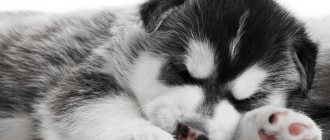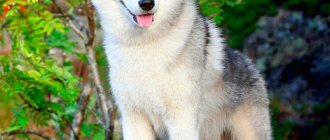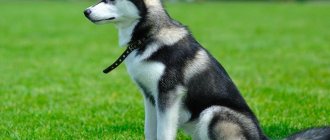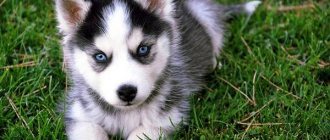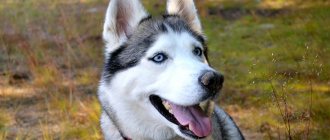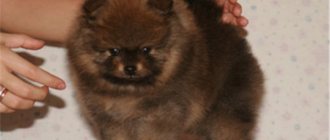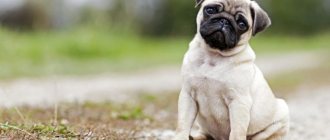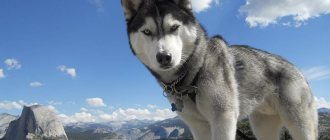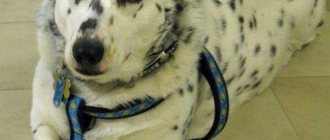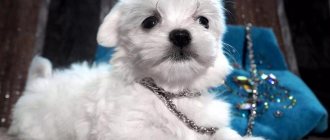A husky puppy is every child's dream. Perhaps everyone has seen this little blue-eyed, furry miracle at least once on the streets of their city. Dogs quickly turned into heroes of social networks and purchasing a puppy of this breed became prestigious. Although few people know how to raise a husky. The confusion arose due to the erroneous opinion about the decorative nature of the breed.
A husky puppy is every child's dream
Choosing a friend
When purchasing a small pet, you will have to learn a lot all over again, for example, the basics of raising a husky. It is important to understand that huskies are already active and mischievous from the age of 1 month, with indomitable energy and the need for constant physical activity. Therefore, if you are buying a puppy for your child or prefer to spend your evenings at home, it is better to think about a different breed. Still determined? Husky puppies will be ideal companions for athletic, motivated and active people!
Mating
Since the history of the Alaskan Klee Kai breed is short, its development is closely monitored by breeders and international cynological organizations. Breeding breeding dogs is recommended and permitted only with the consent of regulatory authorities. Owners who do not comply with this requirement are forced to sterilize their animals.
Before mating, all mini-huskies must be checked for genetic problems and diseases of the thyroid gland, heart, patella, and also treated for helminths.
It is recommended to carry out the first mating at the onset of the third heat. Before this procedure, it is advisable to choose and invite a mating specialist. The litter of miniature huskies is small. Most often, there are 1 – 3 puppies in one litter.
Welcome home
As mentioned earlier, huskies are a social animal, so everyone in the family should spend time with them. But the owner will be one person - the one who spends the most time with the dog. It is advisable to structure your schedule so that the dog receives maximum attention in the first month. This will lay the foundations of behavior, character and determine the owner for the dog.
When little huskies arrive in the house, they should have their own sleeping place, 2 bowls (for food and water) and a cage. The latter is necessary for the safety of the baby himself, since his playful and inquisitive nature can play a cruel joke and lead to injury. To create coziness, you can put toys or a sleeping mat in the cage. Some owners build miniature kennels, it looks beautiful, and the husky sleeps in one with pleasure. While he is small, he sleeps in pet mode most of the time. In this case, it is not difficult to guess how to care for a husky. Take your puppy for a walk after relaxing: just like people, he could use a little activity and fresh air. This will additionally help develop the skill of asking to go outside.
Remember that it is impossible to raise a healthy husky if you leave him at home all day: he is a social animal.
If you adopted a puppy under 2 months old, it may seem that he loves to sleep more than anything else. How does this fit in with the activity and playfulness for which these dogs are chosen? This behavior is natural for babies and requires additional care, because it may seem that dogs do not need walks or fun games. This is wrong.
Breed description, standards and appearance
Although Alaskan Klee Klees look like huskies but are smaller in size, they are distinguished from the Siberian breed by their shorter muzzle, larger ears, and high-set, curled tail. When looking at a miniature husky in profile, you can see that the height at the withers is less than the length of the body.
Representatives of the Mini Husky breed were officially recognized by the American Rare Breeds Association in 1995, and in 1997 the breed was also recognized by the American Kennel Club (UKC).
This is interesting! The International Canine Federation and the Russian Canine Federation do not yet recognize miniature huskies as a separate breed.
The current UKC breed standard gives the following description of the Alaskan Klee Klee:
- The head without unnecessary folds, with a round forehead, has a wedge shape.
- The muzzle is slightly elongated, tapering towards the nose.
- The nose looks convex and is pigmented black.
- Medium size eyes. Their shape can be round, oval or almond-shaped, but always with a black outline. The iris is of various colors, but the most preferred are blue, brown or amber. Often there are representatives of the breed with eyes of different colors, which is not a defect.
- The ears are erect, triangular, with rounded tips, set high and close. They look disproportionately large compared to the size of the head, but this is considered normal.
- Scissor bite. The lower jaw is stronger and more powerful than the upper jaw.
- The neck is of medium length, arched when moving and erect when at rest.
- The mini-husky's body is rectangular in shape, with a wide chest, tucked belly, straight back and strong lower back.
- The limbs are straight, fairly thin, and strong-boned.
- The paws are collected in an oval, with strong toes and thick, rough pads.
- The tail is covered with thick hair, set high and curled into a ring. Usually lies on the back or side of the kli-klay.
- According to the type of coat, the following varieties of the breed are distinguished: short-haired (standard) and long-haired.
- The colors come in a wide variety of shades.
Varieties
According to the UKC standard, the weight of miniature huskies should be proportional to their height at the withers. Depending on their height, Alaskan Klee Klees are divided into the following varieties:
- According to the standard, the height at the withers of small huskies ranges from 38 to 43 cm, weight – from 7 to 10 kg.
- Mini – individuals with a weight of 4.5–7 kg and a height of 33–38 cm.
- Toy - such a small husky will not grow more than 33 cm, and its weight usually does not exceed 4–4.5 kg.
It is important! When conducting a breed examination, height from 43 to 44.5 cm is recognized as a fault, and height at the withers greater than 44.5 cm is considered a disqualifying fault. Such individuals are not allowed into competitions and exhibitions.
Color and coat type
Depending on the type of coat, representatives of the breed are divided into standard (short-haired) and long-haired. Both types are recognized by the UKC. True, there is one important requirement for individuals with long hair - it should not be so long as to hide the natural contours of a miniature husky. Otherwise it will be considered a disadvantage.
It is important! Mini-huskies with any type of coat should have a thick and dense undercoat that keeps the topcoat raised.
The current UKC standard recognizes the following colors of dogs of this breed:
- gray-white (from light to dark shade);
- red-white (from red to dark chestnut);
- black and white;
- plain white (although such individuals are recognized as a standard, they are not allowed for breeding and some exhibitions and competitions).
One of the main features of the Klee Klai is the pronounced mask on its face. Its color should be one or two shades darker than the main coat color, and the pattern should be symmetrical and closed. There should be a white stripe dividing the forehead into two parts. Light eyebrows are encouraged above the eyes.
Gallery: husky puppies (25 photos)
First steps
The newborn is able to crawl slightly to reach the nipples and its brothers and sisters (crowding response) when the mother is not present. While the dog cannot walk, he constantly moves his paws in his sleep. This is the only alternative to make your muscles train.
This type of sleep is called active sleep.
When do puppies start walking? At 18-21 days of life, small dogs begin to stand on their paws, sway, and walk a little. Puppies are no longer so helpless - they see and hear. And now they are trying to get out of their den, playing and biting each other.
Proper education is the key to success
Huskies need to be trained from the first months. For example, the love of freedom of puppies leads to frequent escapes and, if the dog is not taught the appropriate command in time, you will have to constantly keep it on a leash. Call your baby to you, and as a reward for a successfully completed command, you can feed him dog delicacies.
Huskies need to be trained from the first months
With such hyperactivity, raising a husky puppy is not an easy task. It is important to accustom a growing pet to various stimuli that the urban environment is so rich in. The noise of cars, the screams of the crowd, the hum of the subway, other dogs - all this at first will be a kind of test for the dog. Walk him in different places - this will speed up the socialization process.
A common mistake that deserves special consideration is punishment for “wrong” actions. This method is especially harmful if you do not catch the dog damaging furniture, relieving itself in the wrong place, or running away. Use the reverse method of “reward” to reinforce positive qualities without reacting in any way to negative experiences. Husky training goes faster than you think, because they are one of the smartest dogs in the world.
The optimal basis for raising a husky is cognitive and educational games, which are carried out on special grounds or at home. With their help, you will establish communication with the dog and become the “leader of the pack.”
Training a husky puppy is also a scrupulous matter, and it must be done from the first months of life. By prohibiting or allowing the dog something, you form a certain pattern of behavior. This is especially necessary at home, when the husky has no contact with its relatives. Don't encourage your dog to beg, be lazy, or commit petty mischief, and you won't have to regret it when it grows up.
Some historical data
The Siberian Husky breed is one of the oldest, the genomic composition of which differs little from that of a wolf.
The first to tame and domesticate these dogs were the Chukchi.
People in Chukotka used these animals as riding, guard and shepherd animals. Long years of natural selection have produced a healthy, hardy dog breed.
Huskies were first introduced to the states in 1908. During the “gold rush” season, the team with huskies came third to the finish line. After this event, this breed began to be taken more seriously.
The most famous feat performed by this dog occurred in 1925, when the husky dog Balto, in harness with other brothers, along a difficult path of 1085 kilometers, delivered the long-awaited vaccine to the city in order to save the local people of Alaska.However, over time, the Siberian Husky lost primacy in the races to other breeds. Today the entire breed is divided into working, racing and show class representatives.
Selecting a diet
How often do dog owners not care about a balanced diet for their pets and are not afraid to give them table scraps, fatty, sweet or salty foods! Feeding a puppy should be based on the following principles:
- high calorie content;
- easily digestible;
- regularity;
- balance.
Huskies 4 months and younger are recommended to be fed 3 times a day; older puppies can be safely fed twice a day. It is immediately worth noting that the construction of menus for dry and natural food is significantly different. When switching to the first one, you should exclude any other products except fermented milk and vegetables. A “natural” menu should consist of raw meat, boiled offal, cereals, dairy products and boiled vegetables, with slightly less than half of the diet consisting of beef or lamb.
When the dog is four months old, you can introduce complexes of vitamins, micro- and macroelements to strengthen bones and joints, but only if you choose a menu made from natural products. Combining it with dry food will lead to an overdose of beneficial substances and will negatively affect the pet’s health. This does not negate the benefits of natural yogurt, which is easily prepared using store-bought starter and milk.
Another harmful myth is about the benefits of bones in a dog’s diet. For a 5-month-old husky, they are more like a toy than food, but puppies at six months and older can wear down their teeth prematurely and injure their stomach with chips.
Character and behavior
Unlike their not very independent, wayward and reasonable ancestors, little huskies are cheerful and good-natured. They are very sociable and can hardly tolerate loneliness, therefore, when leaving mini-huskies alone, in order to avoid damage to property, you need to provide the dog with all kinds of toys.
Mini-huskies are endlessly loyal to their owner and his family members. They will try to show them their love in every possible way. Miniature huskies get along well with other pets, but they can chase rodents and birds.
Representatives of the breed get along well with children, but they will not tolerate rude behavior from older children - they may bare their teeth or bite slightly. Such situations can be easily avoided by explaining to the child that a dog is a living creature and not a toy.
Mini-huskies behave warily with unfamiliar people, but without aggression. If the dog sees that the owner has a positive attitude towards the guest, his wariness will be replaced by a trusting and friendly attitude.
Due to their size and good-natured nature, small huskies cannot become guards, but they make excellent watchdogs - they will immediately notify their owner of the approach of a stranger with a loud bark.
Taking care of your husky's health
Maintenance and care are criteria for the full development of a dog. Another important point in the life of a husky is vaccination. It’s not enough to just pay attention to your pet and feed it properly. It is necessary to take care of medical methods of protection. This is especially true for dogs that are over 1 year old. So, at two months of age, the time comes for complex vaccination, which consists of 2 vaccinations with an interval of 3 weeks. Before the first of these, it is necessary to carry out deworming (protection against worms). Another vaccination near the end of the husky's first year of life is not necessary, but is recommended by many veterinarians.
Summer is a fun time for huskies. At this time, owners need to be especially careful. Huskies are vulnerable to tick bites, and an undetected insect in time can cause the death of your friend. There are many products on the market that will help protect your dog: from sprays to special collars.
Proper care of a husky puppy, as well as a balanced diet, training and education of a husky will allow your pet to live a long, interesting and eventful life. But it should be remembered that caring and maintaining a pet is the basis of the basics.
Brief history of origin
The history of the Alaskan Klee Klay dog breed began in 1970 in Alaska. At that time, sled dogs were very popular, but not everyone had the opportunity to keep them. American breeder Linda Spurlin decided to create an Alaskan Klee Klay - a mini-husky that could live without any problems even in a small apartment.
Linda initially used Alaskan Malamutes and Huskies to breed the Klee Klay Mini Husky. Then, to reduce their size, the individuals obtained as a result of this mixture of blood were crossed with Oschipperke and Eskimo dogs. The breed was officially introduced to the world in 1988.
This is interesting! The first mini-husky puppies appeared in Russia in 2013.
Switching to adult food
During the first days of their lives, puppies depend on their mother. Newborns can only crawl to their warm mother, find nipples, and suck milk.
On days 18-21, the sucking reflex gradually fades away and the next transition period begins.
Interest in meat and solid foods appears. Now the reaction to irritation of the oral cavity is not sucking, but chewing movements. The enzymes responsible for digesting meat food mature in the dog’s body. The first teeth are emerging. Some bitches regurgitate puppy food.
Your pet’s sense of smell, hearing, and vision are already quite mature. It is during this period that the transition from dairy to mixed nutrition begins. Complementary feeding should start with liquid or porridge feed.
Whether it will be specialized or natural food depends on what you plan to feed the dog in the future. At first, the dog doesn’t pay much attention to the innovation, since his mother’s milk is still his main food.
You cannot force your puppy to eat food.
You can gently poke his muzzle into the food bowl or put a tiny portion in his mouth. Canned food should be mixed in a 1:1 ratio, dry food should be soaked in three parts of water. The raw frozen beef is scraped off with a knife and rolled into small pea-sized balls. Complementary foods are introduced gradually, observing the reaction from the gastrointestinal tract of your pets.
From the very beginning of introducing complementary foods, it is necessary to provide a sufficient amount of fresh drinking water.
When do puppies start eating on their own? From about one month of age, puppies can already eat from a bowl themselves. The owner should make sure that all the kids eat enough, because stronger dogs will eat food from weaker ones.
